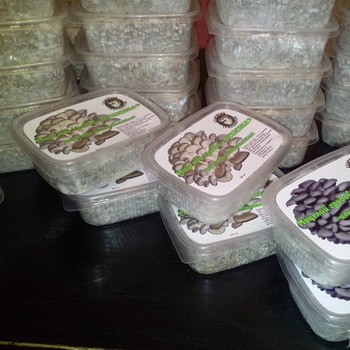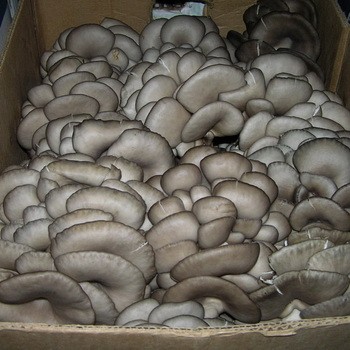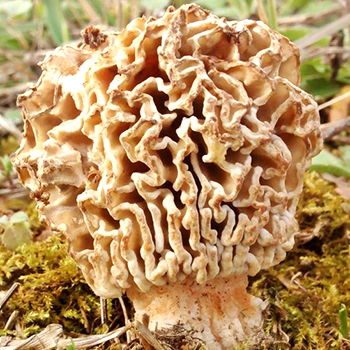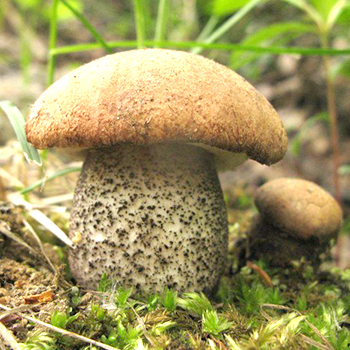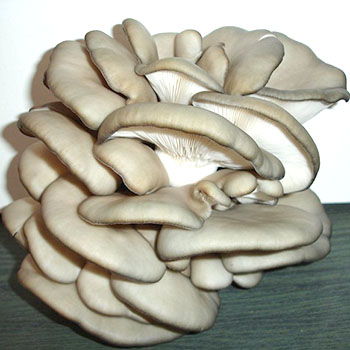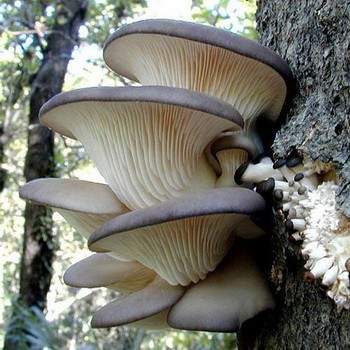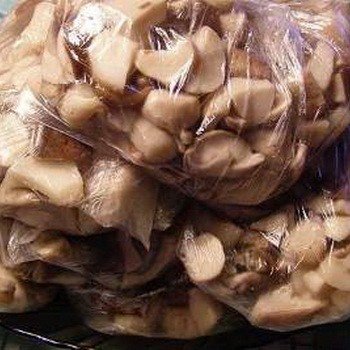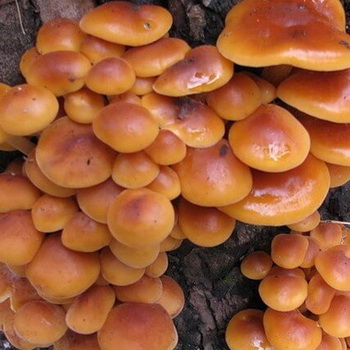Oyster mushroom cultivation: methods and technology for growing
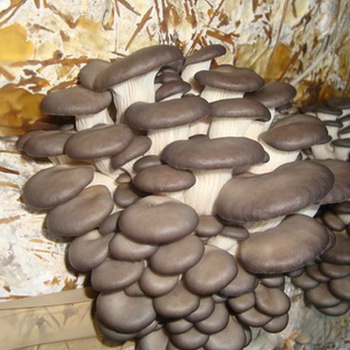
Content
- The technology of growing oyster mushrooms in an extensive way: breeding on stumps
- How to prepare mushroom blocks for growing oyster mushrooms in the country on stumps
- How to grow oyster mushrooms from mushroom blocks and video distillation
- How to grow oyster mushrooms from blocks using non-sterile technology
- Oyster mushroom mycelium distillation during mushroom cultivation
- Growing oyster mushrooms in a room with a laminar flow of air
- Growing oyster mushrooms in a room with a vortex air recirculation system
- Growing oyster mushrooms on substrate briquettes
- Preparation of the substrate for the cultivation of oyster mushrooms in the tunnel
- How to make a substrate for oyster mushrooms using hydrothermal technology
- Preparation and processing of the substrate for oyster mushrooms with water vapor
- How to prepare a substrate for oyster mushrooms in economical ways
- How else can I prepare a substrate for oyster mushrooms
- Growing oyster mushrooms on shelves
- Oyster mushroom growing technology: how to grow mushrooms in bags in greenhouses
The technology of growing oyster mushrooms in an extensive way: breeding on stumps
To grow oyster mushrooms on stumps, mumps infected with mushrooms can be picturesquely installed or dug in a garden plot. The first fruits on thick logs can be expected no earlier than in a year. The thickness of the blocks for the cultivation of oyster mushrooms on the stumps should be at least 10 cm, and a length of 40 cm. On segments of thick logs, fruiting lasts 5-7 years.
Before growing oyster mushrooms, you need to prepare lumps. Trees are cut down for logs during the dormant period, which begins in the fall after leaf fall and continues until the tree sap begins to move in the spring. Suitable for the extensive method of birch and other deciduous trees, except oak and stone fruit. Logs can be stored in late autumn and winter, but not in summer. Dead wood and trees infected with stem rot are not suitable for growing oyster mushrooms in the country on stumps! The logs are sawn into pieces convenient for placement on the garden plot of shape and length. Further operations - drilling holes and sowing logs - are carried out on a clean plastic film! Having retreated 20 cm from the upper end of the stump, a milling cutter with a diameter of 20 mm is made around the circumference of the hole with a depth of 6 cm. The distance between the holes is 4-7 cm.
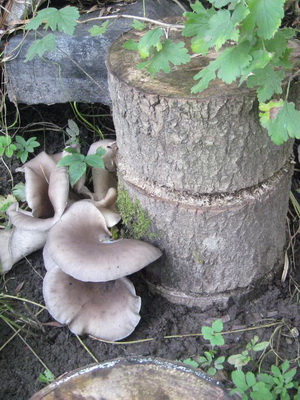
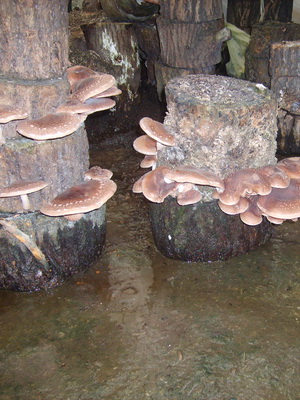
In preparation for growing oyster mushrooms in an extensive way, holes are drilled in stumps in a circle. If the stump is cut off near the ground, drill holes from the end diagonally, starting drilling near the bark. The mycelium spreads quickly along wood fibers, and in other directions - slowly. With clean hands, the holes are filled with mycelium and compacted so that 1 cm remains to the edges. So that the mycelium does not spill out, the holes are closed with a garden var. This is necessary to create a high concentration of carbon dioxide inside the wood.For the best development of wood fungus by mycelium, it is advisable to place the sown log in a plastic bag with small slots for six months.

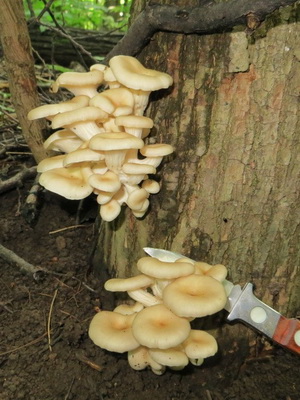
Another version of the technology for growing oyster mushrooms on stumps is to immediately dig a block of wood into the ground. Mushrooms on rooted logs tolerate periods without rains. Choose a place shaded by plants on three sides and open from the west or east. It is better to choose a place in the gully, lowland, where the humidity of the earth and air is higher. If necessary, additional plants are planted that provide protection from the wind.
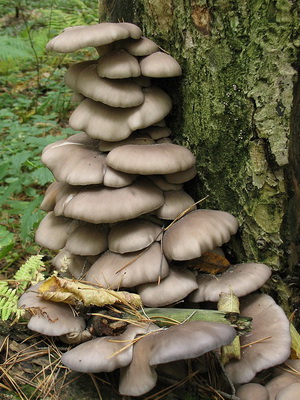

Of all the oyster mushrooms that grow in Russia in deciduous forests at a latitude south of Moscow, the most delicious is oyster mushroom. The natural forms of this fungus require a cold shock to bear fruit. Therefore, they bear fruit in late autumn. More often hybrid varieties bear fruit. The hybrid variety of oyster mushrooms NK-35 is frost-resistant, tasty and does not require mandatory cooling to begin fruiting. Mushrooms of the NK-35 variety, which are grown extensively in the open air, have brown caps, light at high air temperature and very dark at low. The more light, the more intense the brown color of the hat of this variety.
To decorate the garden when growing mushrooms, oyster mushrooms on stumps can be planted on exotic blocks or stumps exotic varieties: lemon yellowYu (Pleurotus citrinopileatus) and pink (Pleurotus djamor) They are very beautiful, but less tasty.
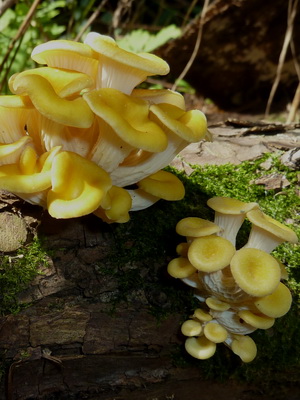

How to prepare mushroom blocks for growing oyster mushrooms in the country on stumps
To prepare one substrate block for growing oyster mushrooms with a volume of 6 liters, take 6 liters of wood chips from freshly ground branches or dried wood chips. Instead of chips, you can take 6-7 liters of chopped straw or husk from sunflower seeds. Add 200 g of barley, oats or pearl barley. With water, bring the mass of the substrate to 3000 g. Add a teaspoon of slaked lime to the substrate - Ca (OH) g.
For the manufacture of small blocks of 3 l when growing oyster mushrooms in the country, it is necessary to reduce the amount of all ingredients by 2 times.
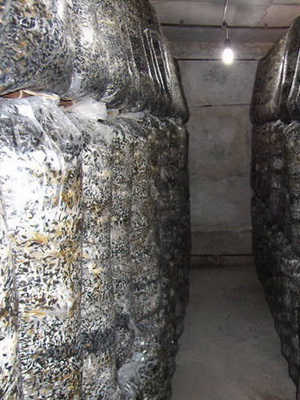
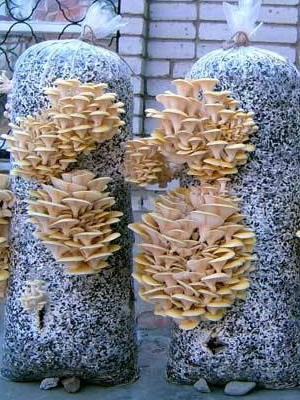
Before growing oyster mushrooms from mushroom blocks weighing 10-20 kg, after thorough mixing, fill the substrate in polypropylene bags of 8 l or 4 liters. Then insert the bag into the throat and tie a stopper made of cotton wool or pure synthetic winterizer with a twine of 2-3 cm in diameter.
Sterilize or pasteurize the substrate directly in the bag in one of the ways. Then, making sure that the substrate has cooled to a temperature below +30 ° C, pour 50 to 100 g of oyster mushroom grain mycelium into the neck of the bag. Place the bags vertically with the cork up in a room with a temperature of +16 ° C to +26 ° C to incubate the mycelium in the substrate. After 3-4 weeks, the substrate will overgrow with mycelium and turn white. Overgrowing time depends on temperature: at +24 ᵒС it is minimal, and at +16 ° С it can increase significantly. Make 6-8 cuts 3-4 cm long in a bag for growing oyster mushrooms with a chisel. Put the bag in the fruiting room.
You can prepare the substrate for oyster mushrooms in a more economical, so-called “Chinese” way. For a block weighing 1.5 kg, take 3 l of substrate base, add 100 g of grain or cereal. Bring the mass of the substrate to 1500 g with water. Add a teaspoon of slaked lime -Ca (OH) 2 to the substrate. Fill the substrate into a 4 L polypropylene bag. Sterilize or pasteurize the substrate directly in an unopened bag in one of the ways. After cooling the substrate below +30 ° C, tie the bag with twine completely tight. On a clean table with clean hands, mash the grain mycelium.
Make with a chisel or knife 6 vertical equally spaced 4 cm slots in the side surface of the bag with the substrate. Insert 1 teaspoon of grain mycelium into each slot. Tape the slots in the bag with tape. To incubate the mycelium in the substrate, place the bags vertically at room temperature 16-26 ° C.After 4-7 days, make sure that the mycelium has formed white spots of overgrowth around the glued slots. After that, make cross-cuts in the adhesive tape measuring 2 x 2 cm, in the same place where they were, and put the bags back into the incubation room. After 20-40 days, depending on the amount of mycelium introduced and on the air temperature, the substrate block for oyster mushrooms will turn white and will be ready for fruiting.
How to grow oyster mushrooms from mushroom blocks and video distillation
Before growing oyster mushrooms, put the packages on shelves or on the ground in the garden vertically. The fruiting bodies of the mushrooms will bear fruit from incisions in the lateral surface. The optimum air temperature during this period is + 13 ... + 17 ° C, air humidity 70-90%. Such conditions in nature occur only in autumn or rainy summers. Particularly little moisture is contained in the air in winter in a heated room. To increase humidity, mushroom blocks for growing oyster mushrooms cannot be simply covered with a bag: because of the high concentration of carbon dioxide, an irregularly shaped mushroom will grow under the bag. A small cultivation chamber with ventilation can be made of polyethylene. Commercially available ultrasonic humidifiers (“cold steam”) can supply fresh humid air to the fruiting chamber with their fan. You must also purchase an electric timer, which will include a humidifier for 5 minutes every hour. In the presence of such a humidifier in the autumn-winter period, you can grow good oyster mushroom on a glazed loggia.
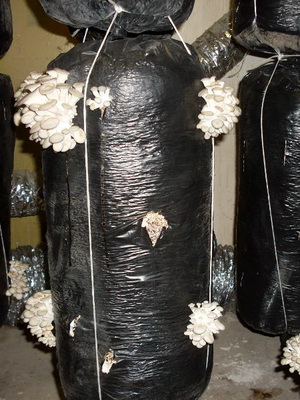
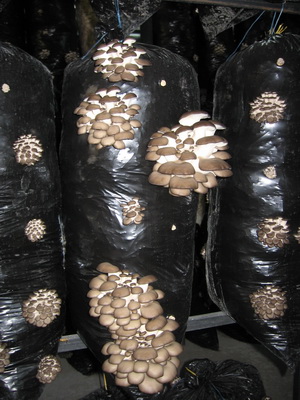
In summer, at elevated temperatures, the appearance of the primordia of fruiting bodies during the cultivation of oyster mushrooms in an extensive way may be delayed. In this case, it is necessary to arrange a “cold shock” for the mycelium. Place the bag with mycelium for 3 days in the refrigerator or in the cellar with a temperature from 0 to +10 ° C, and then return the substrate blocks to the place of their future fruiting. Most likely, there will quickly appear numerous rudiments of fruiting bodies inside the perforated bag. Now the main condition for growing oyster mushrooms is high air humidity with a low concentration of carbon dioxide. Such a microclimate happens among dense vegetation in the shade. For fruiting oyster mushrooms, you need to choose a place protected from the wind and from direct sunlight. To increase humidity, you can water surrounding plants and soil. And after the appearance of fruiting bodies, watering is required for mushrooms.
In the garden, you can put the mycelium in a greenhouse shaded on the south side and moisten the air with regular watering. If there are green plants in the greenhouse, and there are few substrate blocks with oyster mushroom, high-quality mushrooms will grow. With a large number of blocks, a lot of carbon dioxide is released, and the mushrooms will be ugly, lethargic, with an extended leg. To create the necessary conditions for growing mushrooms, oyster mushrooms must be removed from the room carbon dioxide, for this I regularly ventilate the room or install a ventilation system.
Harvest as they appear, while the edges of the hat are bent down, not straightened completely. Carefully break out the mushrooms from the slots of the substrate block, swinging them up and down.
Watch the video “Conditions for growing oyster mushrooms and forcing out mushroom blocks” to better understand the process technology:
How to grow oyster mushrooms from blocks using non-sterile technology
Oyster mushroom has a set of active enzymes that allows it to capture the substrate in a bag and create a high concentration of carbon dioxide there before molds and anaerobic bacteria appear there. Non-sterile technology can be implemented if the substrate is not very infected with mold. Such a substrate may be ground fresh branches of willow or birch.
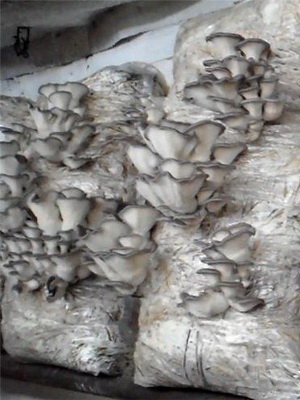
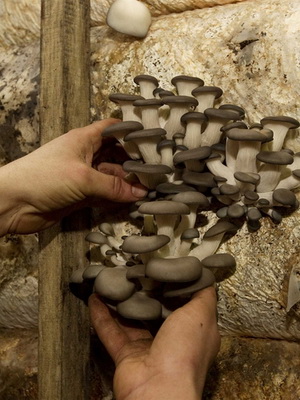
The technology for growing oyster mushrooms in a non-sterile way is quite simple. Place 6 l of wood chips from freshly ground willow branches in a garden shredder in a basin. Scatter slaked lime over the wood chips (1 teaspoon).Using this method of growing oyster mushrooms, chop 200 g of grain mycelium in your hands and add it to the wood chips while stirring. Pour the substrate mixture with such an amount of water to bring the mass of the substrate to 3 kg.
Prepare a bag of polyethylene for 7 liters of contents. Make a synthetic winterizer plug for him. Corks are needed to protect the mycelium from mushroom mosquitoes and so that the oyster mushroom does not begin to bear fruit before you want it.
To make a sintepon stopper, it is enough to cut a piece of sintepon and twist it in the form of a cylinder with a diameter of 4 cm and a length of 6 cm. To make the cork from the sintepon a cylindrical shape, wrap it with thread like a ball for knitting.
Pour the mixture into a plastic bag. It is better if the height of the package is greater than its width. Lower the cork so that the bag is packed tightly with the substrate. Pull off the throat of the bag with twine.
As you can see in the photo, when growing oyster mushrooms, you need to give the substrate block a rectangular shape by gluing the “ears” of the bag to the bottom with tape, so that it stands firmly on the shelf with the cork up:
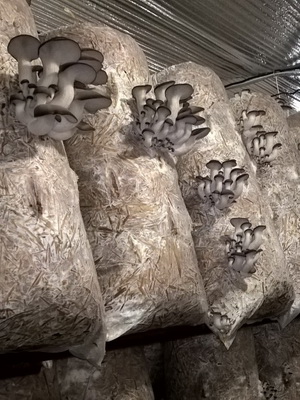
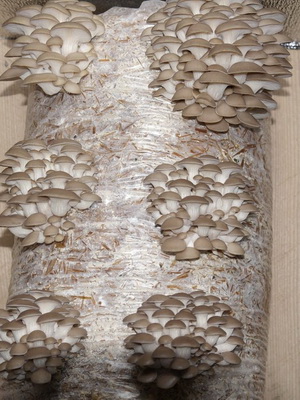
For incubation, place the unit in a room with a temperature of + 20 ... + 24 ° C. A week later, inside the package, white stars of the mycelium appear, which grows near the particles of grain mycelium. First, in the upper part of the block, where there is more oxygen, then white spots will appear in the lower part. After 3-4 weeks, the entire substrate block will turn white. From this moment it can be considered that the substrate block is mastered by mycelium and that the substrate itself has already turned into a full-fledged substrate mycelium. It can be used for distillation of fungi or for sowing new batches of substrate.
To grow oyster mushrooms from the obtained blocks with mycelium, it is necessary to make six vertical 3-cm sections with a knife in the side wall of the packet and put the block in a shady place of the fruit-bearing garden. Mushrooms will grow from these cuts.
You can do it easier - cut the throat of the bag along with the cork, then the mushrooms will grow on top. Place the bags on shelves or on the ground in the garden vertically. The optimal conditions for this stage of cultivation of mushrooms are air temperature + 13 ... + 17 ° C, air humidity 70-90%.
Now watch the video “Growing oyster mushrooms using non-sterile technology”:
Oyster mushroom mycelium distillation during mushroom cultivation
Mycelium for growing oyster mushrooms in an amount of 2 to 5% by weight of the substrate is introduced into the substrate in a clean room: it is poured into plastic bags and compacted. The optimal density of the substrate is 0.4-0.5 kg / l. You can use plastic bags pre-punched with round holes. The optimum mass of the substrate block is 15 kg. The bag is tightly tied with twine on top. Prepared substrate blocks are placed on transport trolleys and transported in small batches to the incubation site.
With a multi-chamber system for growing oyster mushrooms, all phases of development occur in chambers with controlled climate. The first 20 days in a chamber with equipment for growing oyster mushrooms they keep an air temperature of +24 ° C, optimal for incubating mycelium in a substrate, and turn off the ventilation with fresh air. Then the air temperature is sharply lowered to +15 ° С and fresh air is supplied in full to initiate the beginning of fruiting. After 10 days, the mushrooms of the first fruiting wave are harvested, then the conditions are regulated so as to accelerate the appearance of the second wave. In order for the mushrooms to grow evenly on the days of the week, there should be a lot of chambers.
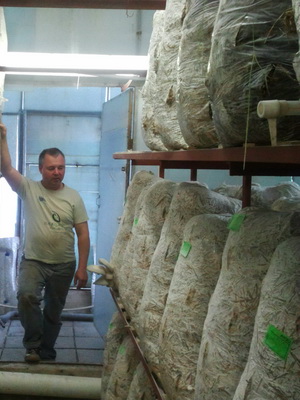
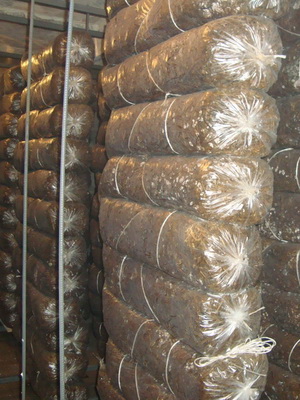
The two-zone, or two-chamber growing system has become more widespread. One third of the cultivation area is reserved for the incubation chamber, where the mycelium assimilates the substrate. The rest of the area is under the fruiting chamber, where fresh air is supplied and where the temperature is constantly maintained at +15 ° С and relative humidity of 80%, optimal for bearing oyster mushrooms.
After inoculation and manufacture of substrate blocks, they are transferred to the incubation chamber.Vertical placement of the blocks provides better convection of air inside the block, but more often they are placed horizontally to save space. To start accelerating the development of the substrate with mycelium, sometimes the blocks are perforated with a chisel only 2-3 days after their placement in the incubation chamber. This technique allows to increase the carbon dioxide content in the substrate at the beginning of incubation.
The optimum temperature of the substrate in the center of the substrate block during incubation is + 25 ... + 27 ° C. Limit values are from +16 to +35 ° С. Air temperature + 20 ... + 24 ° С.
Depending on the technology chosen for growing oyster mushrooms, the relative humidity should be 70-95%, the concentration of carbon dioxide is high (more than 2000 ppm). In the incubation phase, fresh air is not supplied to the cultivation chamber. It is necessary to arrange the substrate blocks so that they are all in the same conditions and can freely give off their biological heat in order to avoid overheating of the substrate. With multi-tiered block placement, cooling may require a block blowing system with recirculated air flows. Light is not required, but acceptable. After the emergence of fungal primordia on some blocks with the same manufacturing date, the entire batch of blocks is transferred to the fruiting chamber.
Growing oyster mushrooms in a room with a laminar flow of air
 When growing oyster mushrooms in a room with a laminar air flow, racks for placing blocks must be made so that the blocks stand vertically in a row in the form of one continuous wall. The distance between the walls is 1 m. The distance between the tiers in height is 70 cm. To prevent the blocks falling out towards the aisle, a removable reinforcing bar is placed on the hooks at the level of the middle of the blocks. Vertical racks must be installed every half meter along the length of the rack. Each rack, when growing oyster mushrooms in a room with a laminar flow of air, is attached by at least two metal dowels to the floor and two to the ceiling. On one side of the rack, reinforcing bars are welded to the supports, on the other they are placed on hooks welded to the supports. At the time of placement of the substrate blocks, the corresponding bar is removed and placed temporarily on another tier.
When growing oyster mushrooms in a room with a laminar air flow, racks for placing blocks must be made so that the blocks stand vertically in a row in the form of one continuous wall. The distance between the walls is 1 m. The distance between the tiers in height is 70 cm. To prevent the blocks falling out towards the aisle, a removable reinforcing bar is placed on the hooks at the level of the middle of the blocks. Vertical racks must be installed every half meter along the length of the rack. Each rack, when growing oyster mushrooms in a room with a laminar flow of air, is attached by at least two metal dowels to the floor and two to the ceiling. On one side of the rack, reinforcing bars are welded to the supports, on the other they are placed on hooks welded to the supports. At the time of placement of the substrate blocks, the corresponding bar is removed and placed temporarily on another tier.
To permanently remove carbon dioxide from oyster mushrooms and to activate the evaporation of water from the surface of the fruit bodies, it is necessary to ensure air movement near the fruit bodies at a speed of at least 0.05 m / s. Under the condition of high relative humidity, a large blowing speed of mushrooms is permissible (up to 5 m / s).
To obtain high-quality fruiting bodies, at least 200 m3 / h of fresh air per one ton of substrate in the chamber must be constantly supplied to the cultivation chamber. In winter, the air from the street must be heated and humidified, which requires large expenditures of thermal energy. Heating with electricity is especially expensive.
The quality of the mushrooms and the harvest also depend on the method of blowing mushrooms with air in the chamber, on the method of air recirculation. The worst solution is to supply heated and humidified air to the chamber, which, after a single passage through the chamber, is removed into the exhaust window using an exhaust fan. It is necessary that the air first passes repeatedly through the growth zone of the mushrooms and only after that, having "collected" carbon dioxide from the mushrooms and from the blocks, it goes out into the street.
One of these air recirculation systems is blowing mushrooms with a laminar flow of air.
Walls with blocks are placed along the long side of the chamber at a distance of 1 m from one another. A corridor (passage) unoccupied by mushrooms is left parallel to the racks with mushrooms and fenced off from them by a light partition. High-performance axial fans, heaters and humidifiers are installed in the corridor. Such a corridor is called a “climate corridor”. Fresh air is also served there.The air of the chamber is driven by the fans along the corridor, where it is moistened and heated, and returned through the zone of placement of the walls with substrate blocks. The air circulates many times, blowing mushrooms. Once saturated with carbon dioxide, it is removed into the exhaust window under the pressure created by the fresh air supply fan, whose performance is much lower than the axial fans in the corridor.
Here you can watch a video of growing oyster mushrooms in a room with a laminar flow of air:
Growing oyster mushrooms in a room with a vortex air recirculation system
Bags with the substrate in the chamber are placed in the form of high vertical continuous walls perpendicular to the long side of the cultivation chamber. The distance between adjacent racks is 1 m. The zone with mushrooms is separated from the walls from all sides by aisles. The width of one passage is 2 m, the remaining three - 1 m. A two-meter longitudinal passage, not fenced off from the zone with mushrooms, serves as a climatic corridor. It installs a jet fan. The required amount of fine humidifiers (aerosol generators of the AG-1 type) is suspended above the air stream created by the jet fan. Fresh air is supplied to the chamber through the window. It displaces the exhaust air along with the carbon dioxide released by the mushrooms through the exhaust window in the ceiling of the chamber. At moderate outdoor temperatures, it can be supplied with a separate fan directly from the street. But in winter the air must be preheated. The system of preliminary preparation of fresh air includes a medium-pressure radial fan in an amount of at least 200 m3 / h per each ton of substrate.
Air is taken from the street through the mosquito net, passes through the air pre-heater until positive temperatures are reached, then it enters the mixing box, where it can be mixed with the chamber air. The adjustment valve in the mixing box allows you to adjust the amount of air relative to the air from the chamber. Between the mixing box and the fan, the main electric air heater or heating heat exchanger is installed. In the ventilation system, fresh air is heated to the desired temperature and enters the "climatic corridor" through the window. The total thermal power of two heaters can be approximately estimated at the rate of 2-3 kW for every 200 m3 / h of fresh air supplied. Fresh air heating and the time for switching on aerosol generators are regulated so that the air temperature in the chamber is +15 ° С at a humidity of 80%. In the absence of outdoor air coolers in summer, fresh air may have a higher temperature, but aerosol generators reduce it by several degrees.
The powerful and narrow stream of air created by the jet fan organizes the circular movement of air around the shelves with mushrooms. The jet itself and these streams, in accordance with the Bernoulli law, create a pressure gradient in the chamber, which ensures the movement of air through the passages between the racks, washing the mushrooms. In the passages closest to the fan, the air moves to the "climatic corridor", and in the farthest - from it.
The circular movement of air around the shelves with mushrooms also leads to air circulation near the mushrooms. Such a vortex air recirculation system improves the removal of carbon dioxide from fungi and from slots in bags.
The air stream in the central passage also performs the function of mixing the chamber air well with the warm air from the fan, with steam and with water spray.
Watch the video how to grow oyster mushrooms in a room with a vortex air recirculation system:
Growing oyster mushrooms on substrate briquettes
 Large-scale enterprises use equipment for growing oyster mushrooms in the form of Italian-made automatic briquetters with a capacity of about 360 briquettes per hour.After cooling the substrate in the tunnel, it is unloaded by electric winch onto the conveyor belt of the briquetting machine, where the mycelium dispenser is installed and the substrate is seeded. Then, the inoculated substrate enters the press chamber, where the briquette is formed and packaged in a perforated film.
Large-scale enterprises use equipment for growing oyster mushrooms in the form of Italian-made automatic briquetters with a capacity of about 360 briquettes per hour.After cooling the substrate in the tunnel, it is unloaded by electric winch onto the conveyor belt of the briquetting machine, where the mycelium dispenser is installed and the substrate is seeded. Then, the inoculated substrate enters the press chamber, where the briquette is formed and packaged in a perforated film.
The parameters of the finished substrate for oyster mushrooms: humidity = 70-74%, pH = 7.5-8.5, total nitrogen (1 \ 1general) = 0.7-1.0%, the color is uniformly brown, the density of the substrate is 0.45 -0.50 kg / l. Overall dimensions of briquettes of oyster mushroom substrate 35 x 55 x 22 cm, weight 20-22 kg.
The following is an example of a simple, practical option for forcing mushrooms from briquettes. The substrate in briquettes is placed on four four-tier racks. The chamber accommodates 20 tons of substrate. The specific load of the substrate is 180 kg per 1 m2 of the chamber floor. In winter, the air is heated by steam heating batteries. Fresh air enters the fruiting chamber through the vents. The volume of fresh air and air temperature are regulated by the degree of opening of the windows. The air flow passes through the shelves with mushrooms and is removed by an exhaust fan. The air in the chamber is humidified by one AG-1 aerosol generator, which is suspended under the ceiling of the chamber in the central passage. An axial fan with a capacity of 1700 m3 / h is suspended in front of the aerosol generator. It creates a stream of air that traps the “fog” from the generator and mixes the air in the chamber. The fine atomizer AG-1 and the fan are turned on together by timer.
An exhaust fan with a capacity of 5000 m3 / h is mounted in the chamber wall opposite from the window. Fans turn on by timer every half hour for 5 minutes. In the summer, the system works fine and allows you to get good quality mushrooms. In winter, it is necessary to limit the air supply due to insufficient power of the heating system. In winter, during operation of the exhaust fans, frosty fresh air enters through the window. However, the mushrooms do not have time to freeze and grow well enough. During incubation of the mycelium, the windows are closed, exhaust fans do not work. They open the windows and turn on the exhaust fans for a short time only if the temperature in the center of the unit rises above +35 ° С. After that, the temperature in the chamber is maintained from +13 to +20 ° C. Productivity for two waves of fruiting reaches 20% of the mass of the substrate.
Preparation of the substrate for the cultivation of oyster mushrooms in the tunnel
 In champignon complexes in large quantities produce a substrate for oyster mushrooms in the same tunnels as champignon compost. The good quality of the oyster mushroom substrate made in the tunnel on the farm where the champignon compost is made is explained by the use of recycled water from the champignon workshop with aerobic microorganisms. On farms where champignons are not produced, the substrate for oyster mushrooms is improved by adding manure to the circulating water in an amount of up to 10 kg per ton of straw.
In champignon complexes in large quantities produce a substrate for oyster mushrooms in the same tunnels as champignon compost. The good quality of the oyster mushroom substrate made in the tunnel on the farm where the champignon compost is made is explained by the use of recycled water from the champignon workshop with aerobic microorganisms. On farms where champignons are not produced, the substrate for oyster mushrooms is improved by adding manure to the circulating water in an amount of up to 10 kg per ton of straw.
Standard technology for preparing a substrate for growing oyster mushrooms begins with chopping straw. Grinding straw to particles with a size of 3-8 cm is necessary so that in the future it is easier to stuff the substrate in bags. The straw is moistened with circulating water on a concrete site for 1-5 days, periodically turning over. The humidity of the straw when loading the tunnel should be at the level of 78%. The tunnel is filled with a straw layer up to 2.5 m, so that its surface is even. After pasteurization, the straw layer settles significantly. To place 1 ton of substrate straw, about 1.5 m2 of the tunnel floor area is required.
After loading, the tunnel is closed and recirculation ventilation is turned on to equalize the temperature in the substrate mass. Then start adding 1% fresh air. In winter, for the initial heating of the substrate for growing oyster mushrooms, steam is supplied from below along with air. After some time, the rise of microbiological activity begins in the substrate.The substrate begins to heat up itself, and to maintain the pasteurization temperature, less and less steam and more (up to 5%) of fresh air is required. The temperature is raised slowly, heating the substrate takes 12 hours in the summer and up to 24 hours in the winter. The steam generator must provide 25 kg of steam per hour for each ton of substrate.
Upon reaching a temperature of +65 ° C, the pasteurization process begins. During pasteurization, the fresh air supply is 5% of the total recirculation, or 10 m3 / h per 1 ton of substrate. After twelve-hour pasteurization for subsequent fermentation, the substrate is cooled to +50 ° C (within 8-10 hours) by increasing the volume of fresh outdoor air to 30%. Then the substrate is fermented at + 45 ... + 50 ° C from 24 to 48 hours when a large volume of fresh air (20%) is supplied. At the end of pasteurization or fermentation, they try to quickly cool the mass of the substrate with fresh air, which at this moment is admitted in a volume of up to 100%. When preparing the substrate for oyster mushrooms, it is cooled to +28 ° C in winter, and in summer to +24 ° C. The cooling process takes from 12 to 24 hours, depending on the season and ambient temperature.
When preparing the substrate for oyster mushrooms, it is unloaded by a conveyor, a winch with a system of moving floors (nets), other mechanisms or manually. Mycelium is introduced into the substrate in a proportion of 2 to 5% by weight of the substrate. Inoculation is carried out in a clean room located next to the heat treatment chamber. The mycelium is evenly distributed in the substrate and the resulting mixture is Packed in plastic bags.
How to make a substrate for oyster mushrooms using hydrothermal technology
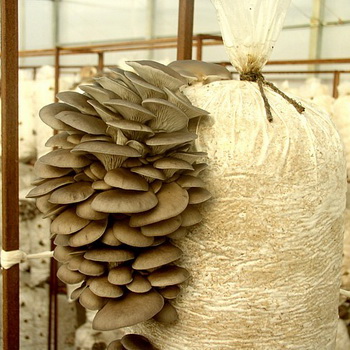 The most affordable technology for heat treatment of the substrate, which is the most affordable for oyster mushroom production, is soaking the substrate in bags in hot water. The tank for hydrothermal treatment is a metal tank with electric water heaters in the lower part and with a horizontal grid above the heaters.
The most affordable technology for heat treatment of the substrate, which is the most affordable for oyster mushroom production, is soaking the substrate in bags in hot water. The tank for hydrothermal treatment is a metal tank with electric water heaters in the lower part and with a horizontal grid above the heaters.
Before preparing the substrate for oyster mushrooms using hydrothermal technology, the crushed straw in dry form is loaded into new or used woven polypropylene bags, in which sugar is usually packed. You can also make a substrate from sunflower husk without additives or from equal parts of wood chips and cotton tows. The bags with the substrate are placed vertically, closed on top with floaters and covered with a lid. The tank is filled with water. The substrate in the bags should be 96 completely covered with water. Heating lasts 12-13 hours. The water temperature should not rise above 82-85 ° C. After the temperature is reached, the heaters are turned off and the substrate is kept in water for 4 hours. Then the water is drained. And you can unload hot bags from the tank onto the slatted floor, where you can leave it overnight. In the morning, inoculation of the substrate with mycelium begins in a separate clean room. The substrate is taken from the box in separate bags and shaken on the inoculation table. The temperature of the substrate during inoculation should not exceed +
30 ° C.
Along with the above, there is another option for hydrothermal treatment of the substrate. Dry straw or a husk of sunflower is previously laid in a container and covered with a heavy shield that will not allow it to emerge. Heated water in boilers or in special tanks to a temperature of +80 ° C is poured into a container so as to completely close the substrate. The temperature of the water after heat exchange with the substrate is +70 ° C. The substrate is left under water overnight. In the morning, the water is drained. After a few hours, inoculation and the production of substrate blocks begin.
The sunflower husk substrate allows accelerated hydrothermal treatment by boiling in water. Sunflower husk is packed in woven polypropylene bags, kept for 4 hours in a tank with warm water at a temperature of about +30 ° C. Then a rope of sufficient length is tied to the bags and immersed in a tank of boiling water. After 30 minutes, the bags are taken out of boiling water and suspended on ropes.Water drains from the bags and they are dried until the next morning. After the substrate has cooled to +30 ° C, inoculation with mycelium is performed. Up to 5 servings of substrate can be passed through one portion of water.
The main disadvantage of hydrothermal technology is the strong waterlogging of the substrate. With excess water, anaerobic zones occur in the substrate. Dark spots appear on the substrate block, mold develops, water accumulates in the lower part of the bag, and mushroom flies are bred faster.
The least moisture is obtained by cooking the substrate, followed by drying the bags in a suspended state. It should be noted that excessive waterlogging of the substrate is less manifested when cotton tows are used as the basis.
Preparation and processing of the substrate for oyster mushrooms with water vapor
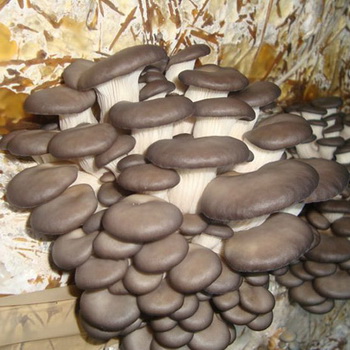 The substrate is first moistened in one way or another to the desired moisture content (W = 60%), then it is placed on the nets in the tank and treated with steam for 4 hours under the leaky cover, counting from the moment the substrate is heated to +90 ° C. The steam supply is stopped and the substrate is allowed to cool overnight. In the morning, transfer the substrate to a clean room for inoculation. This technology has proven itself when processing a substrate with cotton tow. It is convenient to use a small tank with internal dimensions of 1.0 x 1.0 x 1.0 m, which has a fitting for draining water and a steam supply system for the substrate. Corners are welded inside the tank, onto which the mesh reinforced with a corner for the substrate is installed. Nets with handles measuring 100 x 33 cm are installed in three on each floor. A pre-soaked substrate is laid out on a mesh with a layer of 20 cm. On each mesh lies a weight of 30-35 kg. After heat treatment, two workers easily lift such a net and carry it to the inoculation table.
The substrate is first moistened in one way or another to the desired moisture content (W = 60%), then it is placed on the nets in the tank and treated with steam for 4 hours under the leaky cover, counting from the moment the substrate is heated to +90 ° C. The steam supply is stopped and the substrate is allowed to cool overnight. In the morning, transfer the substrate to a clean room for inoculation. This technology has proven itself when processing a substrate with cotton tow. It is convenient to use a small tank with internal dimensions of 1.0 x 1.0 x 1.0 m, which has a fitting for draining water and a steam supply system for the substrate. Corners are welded inside the tank, onto which the mesh reinforced with a corner for the substrate is installed. Nets with handles measuring 100 x 33 cm are installed in three on each floor. A pre-soaked substrate is laid out on a mesh with a layer of 20 cm. On each mesh lies a weight of 30-35 kg. After heat treatment, two workers easily lift such a net and carry it to the inoculation table.
In the middle climatic zone of Russia it is more rational to use birch and aspen firewood. On a mushroom farm in the Volokolamsk region, oyster mushroom is successfully grown on steamed wood aspen. Wood trunks with a diameter of not more than 20 cm are crushed in a crusher to small chips with a size of 10-30 mm. Thicker firewood has to be cut into several parts before grinding. The natural moisture content of firewood is 40-50%. The nitrogen content in wood is only about 0.1%. Therefore, in the substrate, oat or barley grain is additionally added in an amount of 20% by weight of wood. Heat treatment and mixing is done in a substrate machine, which is a barrel rotating on the axis. You can conveniently load wood chips and grain into it, pour water, apply steam and mix everything.
Wood chips are loaded pneumatically by a dust fan into a substrate machine. Since the chips are quite heavy, loading is quick. Then add the grain of oats or barley at the rate of 20% by weight of wood chips and water. The amount of water is calculated based on the initial and desired moisture content of the substrate. The optimum moisture content of the substrate mixture is from 65 to 70% - in this case there will be no free water in the substrate. Then, stirring this mixture, steam is supplied for heating. The mixture is heated to + 90 ° C and maintained at this temperature for 2 hours. Steam supply does not greatly increase the substrate moisture, but still, when testing the technology, it is necessary to measure the humidity of the finished substrate and adjust the amount of added water.
Instead of a substrate machine, you can use a steaming tank, but in this case, the chips are pre-mixed with grain and the required amount of water on a clean concrete floor.
After cooling, mycelium is added to the substrate, mixed thoroughly and packaged. The mass of the bag is 16-18 kg.
The incubation time when processing the substrate for oyster mushrooms on wood-mixed substrate mixed with grain is 25 days. The yield of mushrooms on the first wave is from 15 to 18% by weight of the block. Oyster mushrooms are beautiful, dense and fragrant.
How to prepare a substrate for oyster mushrooms in economical ways
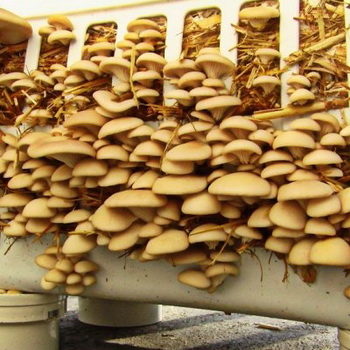 To make a substrate for oyster mushrooms, you can use one of the following economical methods.
To make a substrate for oyster mushrooms, you can use one of the following economical methods.
Xerothermic processing of the substrate. When using this technology, less energy is spent on heating the steam, since the heat capacity of dry straw is less than the heat capacity of wet straw. Dry straw is treated with steam, then cold clean water is added to the substrate on a clean floor. Chopped straw is fed via a conveyor or pneumatic conveyor to the heat treatment hopper, where its temperature is brought to + 95 ... + 100 ° С by steam. Processing at this temperature lasts 1-2 hours. Straw for xerothermal technology should be free of mold. After xerothermic treatment, dry sections of straw always remain, and a temperature of +160 ° C is required to destroy dry mold spores.
Anaerobic substrate fermentation in water - this is keeping the substrate in water without air at temperatures from room temperature to +60 ° C. The substrate can withstand up to three days. At the same time, its protection against mold is developed. Qualitative indicators of substrate readiness are the unpleasant odor of anaerobic processes and the presence of a bacterial film on the surface of the water. Lowering the temperature to + 30 ... + 40 ° C leads to the fact that the smell becomes intolerable and the properties of the substrate deteriorate. At low temperatures, fermentation takes from one to two weeks, but low-temperature anaerobic treatment, despite its economy, is not widespread. All the disadvantages of hydrothermia are also characteristic of anaerobic fermentation (except for high energy consumption).
How else can I prepare a substrate for oyster mushrooms
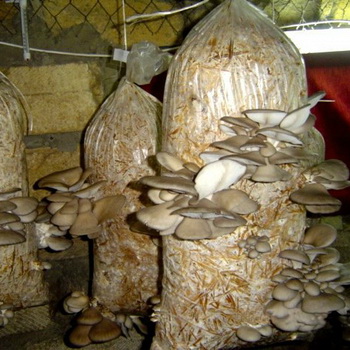 You can also prepare a substrate for oyster mushrooms by processing in sealed barrels without access to air and without heat treatment.
You can also prepare a substrate for oyster mushrooms by processing in sealed barrels without access to air and without heat treatment.
Processing the substrate in airtight barrels without air. Soaked to the desired moisture content, the substrate is processed in an air environment, but without access to fresh air during heat treatment. Pasteurization without air access is carried out at a temperature of + 60 ... + 70 ° C in sealed containers. The difference from hydrothermal and anaerobic fermentation is the absence of free water in the gaps between the particles of the substrate. The substrate is processed in a heat chamber in hermetically sealed barrels. Oxygen is consumed by the beneficial microflora of the substrate, so the lids of the barrels are attached to the barrels due to the pressure difference. The result of the technology is good enough with a substrate moisture content of 65%. An accurate calculation of the amount of added water is needed.
The manufacture of the substrate without heat treatment. Sunflower husk, warmed up at the oil mill, not being in the rain, can give a good result without heat treatment. The husk is soaked for 2 days at room temperature in water with slaked lime, which does not dissolve and basically remains at the bottom of the tank. Then it is left overnight on a net for draining water. In the morning, add mycelium in an amount of 1-3% and fall asleep in perforated plastic bags designed for 10 kg of substrate. Harvest on the first wave reaches 18% of the wet mass.
Growing oyster mushrooms on shelves
In some farms intended for growing champignons, oyster mushrooms are successfully grown on shelves. The substrate briquettes seeded with mycelium are tightly laid on racks 140 cm wide in the form of a bed 20 cm thick. Perforation is done only from above. When using a bulk, seeded with mycelium oyster mushroom substrate, it is poured on the shelf in an even layer, compacted and covered with a perforated plastic film. When growing oyster mushrooms on shelves, the mushrooms will grow vertically upward, and their shape will be almost symmetrical, like mushrooms growing on the ground.
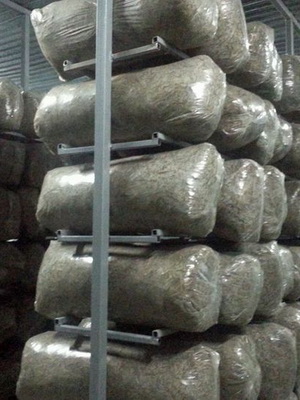

The climate parameters in the chamber are controlled in accordance with a predetermined cultivation schedule. For example, consider a typical champignon chamber. The width of the chamber with shelves for oyster mushrooms is 6.0 m. With a chamber height of 2.8 m, 4-tier racks can be placed in it. The width of the middle passage is exactly 1 m. The length of the shelves is 17.5 m, the width is 140 cm.The distance from the floor to the shelf of the 1st tier is 20 cm, between the shelves (in height of the tier) 60 cm. For a bulk substrate, a shelf in the form of a trough with sides 20 cm is needed. On the shelf, the substrate is 20 cm thick, above it an air gap of 35-40 cm Substrate briquettes are laid closely in the form of four lines with a width of 35 cm. It turns out the width of the beds 140 cm. Full load of the camera - 20 tons of substrate. For the normal development of oyster mushrooms during the fruiting period, ventilation with fresh air should be no less than 200 m3 / h per ton of substrate. To press the air through a conditioning system with a polyethylene duct, a pressure of 400 Pa is required. In this case, a radial
fan with a capacity of 4000 m3 / h at an operating pressure of 400 Pa. The polyethylene air duct in the chamber is an air-blown polyethylene sleeve with a diameter of about 50 cm, equipped with downward nozzles with a diameter of 6 cm. The air duct is suspended under the ceiling in the middle of the central passage, so that the air flow from the nozzles is directed vertically downward. The length of the duct is 17 m. The end of the duct farthest from the air conditioner is muffled. The air duct is made of a polyethylene sleeve 80 cm wide with a film thickness of 100 microns. The distance between the nozzle openings is 50 cm, and the number of nozzles in the duct is 33.
At a sufficiently high speed of air outflow from the nozzles, a circular movement of air begins around the racks - the air goes down in the passage with the air duct and rises in the passages where there are no air ducts. When growing oyster mushrooms on racks, jets of air from nozzles create reduced pressure in the upper half of the aisle and increased pressure in the lower half. The pressure difference makes the air move above the surface of the beds. Such an air distribution system mixes the chamber air well and evens the air temperature over the volume of the room. Oyster mushroom yield is about 20% in relation to the mass of the substrate. Dense, heavy mushrooms of excellent quality grow.
Oyster mushroom growing technology: how to grow mushrooms in bags in greenhouses
There is another technology for growing oyster mushrooms - in bags placed in greenhouses. It is used in some farms in the autumn-winter period, in between vegetable turnover. The agro-industrial complex Moskovsky has long successfully practiced growing oyster mushrooms in greenhouses free of vegetables in the winter. Empty glass greenhouses cannot keep snow on the roof, so the air in them is heated all winter. Heat for growing mushrooms is free.
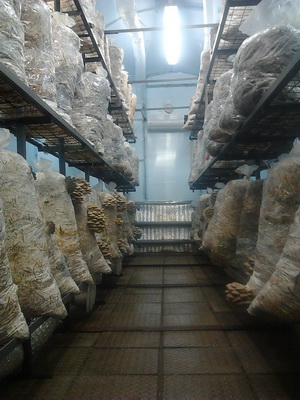
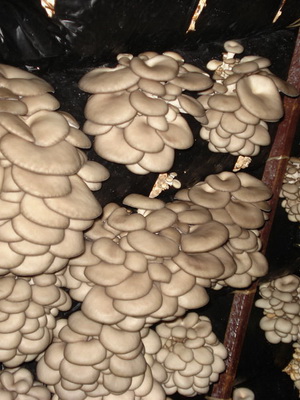
The technology for the forcing of mushrooms at AGC Moskovsky was extremely simple. The substrate prepared in pasteurization tunnels was mixed with mycelium (3%) and poured into plastic bags of 20 kg of substrate each. Bags for growing oyster mushrooms were tied, perforated with their knives on their side surface and transported to incubation in an empty concrete vegetable store or in a storage room with an area of up to 800 m2. The bags were placed on the floor at short intervals, and the air temperature was raised to + 5 ... + 10 ° C by portable heaters. After that, the substrate blocks, warming themselves, help the heaters. The air temperature in the oyster mushroom greenhouses for mushrooms was maintained in the range of + 20 ... + 28 ° С depending on the temperature of the substrate inside the blocks, which should not exceed 35 ° С. After 20-25 days, those blocks that were overgrown with mycelium were transported for forcing mushrooms into the greenhouse.
In greenhouses with an area of more than 1000 m2, equipment is used for growing oyster mushrooms with heating registers on the periphery, an irrigation system (irrigation) and open transoms for ventilation. A 5 cm thick layer of pine wood was poured onto the ground. There are no fans, no air humidity sensors, or CO2 meters. On frosty days, fresh air ventilation was carried out only through gaps in the gates, sometimes opened for the export of carts with collected mushrooms and for the placement of new bags with a substrate.To irrigate the soil and air, two irrigations per day were carried out. In order to grow oyster mushrooms in the greenhouse, irrigation (intensive sprinkling over the entire surface of the greenhouse) was switched on for 10 minutes at noon and at 3 pm. To avoid yellowing of the fungi (their bacteriosis), it is necessary to ensure that by evening the mushrooms dry out of the water. The only parameter that was automatically maintained was the air temperature + 12 ... + 15 ° С. Ventilation transoms when growing mushrooms in the greenhouse of oyster mushrooms were opened only occasionally, in spring or autumn. Due to the low density of the substrate (less than 50 kg / m2 of the earth's surface) and the large amount of air in the greenhouse, the mushrooms grew in high quality. Productivity reached 17% for a cultivation cycle of 90 days (3 waves).
A layer of wood chips or sawdust with a thickness of 4-6 cm is poured onto greenhouse soil. In the future, this coating is constantly kept moist during fruiting. Evaporation of water from the chips provides a normal regime of humidity for the formation of high-quality mushrooms.
